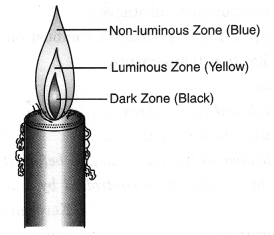NCERT Solutions for Class 8 Science Chapter 6 Combustion and Flame are part of NCERT Solutions for Class 8 Science. Here we have given NCERT Solutions for Class 8 Science Chapter 6 Combustion and Flame.
| Board | CBSE |
| Textbook | NCERT |
| Class | Class 8 |
| Subject | Science |
| Chapter | Chapter 6 |
| Chapter Name | Combustion and Flame |
| Number of Questions Solved | 13 |
| Category | NCERT Solutions |
NCERT Solutions for Class 8 Science Chapter 6 Combustion and Flame
NCERT TEXTBOOK EXERCISES
Question 1.
List conditions under which combustion can take place.
Answer.
Conditions under which combustion can take place are as follows :
- The presence of air (oxygen).
- The ignition temperature should be reached.
- A source of inflammable substance.
Question 2.
Fill in the blanks:
- Burning of wood and coal causes………….of air.
- A liquid fuel, used in homes is…………..
- Fuel must be heated to its………… before it starts burning.
- Fire produced by oil cannot be controlled by……………..
Answer.
- pollution
- Kerosene
- ignition temperature
- water.
Question 3.
Explain how the use of CNG in automobiles has reduced pollution in our cities.
Answer.
CNG is a clean fuel. It produces harmful products in a very small amount. That is why pollution in our cities has reduced.
Question 4.
Compare LPG and wood as fuels.
Answer.
| LPG | Wood |
| 1. No residue after burning. | 1. Leaves a lot of ash on burning. |
| 2. It can be easily stored in cylinders for convenient transportation. | 2. Cannot be transported easily like LPG. |
| 3. Burns easily. | 3. Catches fire with more difficulty. |
| 4. Low ignition temperature. | 4. High ignition temperature. |
| 5. No smoke on burning. | 5. Burns with smoke. |
Question 5.
Give reasons:
- Water is not used to control fires involving electrical equipment.
- LPG is a better domestic fuel than wood.
- Paper by itself catches fire easily whereas a piece of paper wrapped around an aluminium pipe does not.
Answer.
- Water is not used to control fires produced by .electrical equipment because water is a conductor of electricity and may cause electrocution or electric shock.
- LPG is a substance which is readily available. It is cheaper and bums easily in the air at a moderate rate. It produces a large amount of heat and does not leave behind any undesirable substance.
- Paper catches fire easily, but when it is wrapped around an aluminium pipe and heat is supplied then in the presence of aluminium pipe, the ignition temperature of the paper does not reach, because heat given to it is passed to the aluminium pipe which lowers the temperature of the paper. That is why the paper does not catch fire.
Question 6.
Make a labelled diagram of a candle flame.
Answer.
Fig. 6.1. Different zones of a candle flame
Question 7.
Name the unit in which the calorific value of a fuel is expressed.
Answer.
The calorific value of a fuel is expressed in kilojoules per kg (kJ/kg).
Question 8.
Explain how CO2 is able to control fires.
Answer.
CO2, being heavier than oxygen, covers the fire like blanket and also brings down the temperature of fuel. Since the contact between the fuel and oxygen is cut off, the fire comes under control.
Question 9.
It is difficult to burn a heap of green leaves but dry leaves catch fire easily. Explain.
Answer.
Green leaves contain a lot of water. So, when we try to burn green leaves, water present in the leaves cools the combustible materials (leaves), so that their temperature is brought below their ignition temperature. This prevents the burning of green leaves.
On the other hand, dry leaves do not contain any water. So when a burning process starts, their temperature is raised drastically above their ignition temperature and the leaves catch fire easily.
Question 10.
Which zone of a flame does a goldsmith use for melting gold and silver and why?
Answer.
A goldsmith uses the outermost zone of a flame for melting gold and silver because it is the hottest zone of the flame (temperature ≈ 800°C) and is non-luminous in nature.
Question 11.
In an experiment, 4.5 kg of fuel was completely burnt. The heat produced was measured to be 180,000 kJ. Calculate the calorific value of the fuel.
Answer.
The calorific value of the fuel:
Calorific value = heat produced/amount of fuel = 1,80,000 kJ/4.5 kg = 40,000 kJ/kg
Question 12.
Can the process of rusting be called combustion? Discuss.
Answer.
Yes, the process of rusting can be called combustion, in fact, slow combustion because rusting also takes place in the air (O2) in the presence of humidity.
Question 13.
Abida and Ramesh were doing an experiment in which water was to be heated in a beaker. Abida kept the beaker near the wick in the yellow part of the candle flame. Ramesh kept the beaker in the outermost part of the flame. Whose water will get heated in a shorter time?
Answer.
The water of Ramesh’s beaker will get heated in a shorter time because the outermost part of the flame is the hottest.
We hope the NCERT Solutions for Class 8 Science Chapter 6 Combustion and Flame help you. If you have any query regarding NCERT Solutions for Class 8 Science Chapter 6 Combustion and Flame, drop a comment below and we will get back to you at the earliest